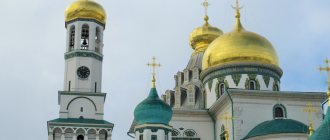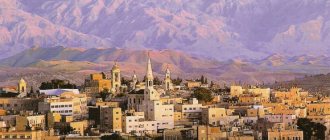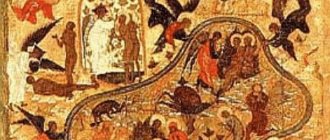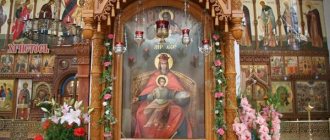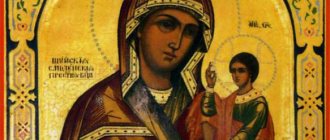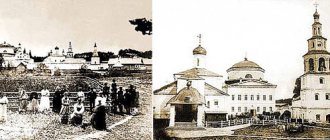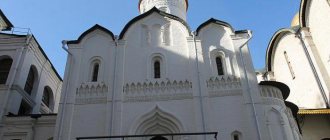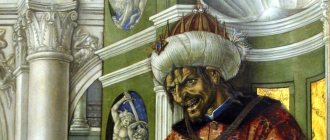| Konevskaya Icon of the Mother of God. No later than the 14th century. New Valaam Monastery |
Konevskaya Icon of the Mother of God
Celebration of July 10
This icon was brought from Saint Athos by the Monk Arseny Konevsky in 1393. The Monk Arseny spent three years on Mount Athos, worthy of laboring in the feats of fasting and prayer. After this period, he decided to return to his native Novgorod in order to revive there the ancient traditions of Athonite monasticism. The abbot of one of the Athos monasteries, the Monk John Zidon, admonishing his beloved disciple, blessed the Monk Arseny on his journey with the miraculous icon of the Mother of God (on Athos the icon was called Akathist) and predicted to him that he would be the abbot of the newly-minted monastery.
Returning to Rus', the Monk Arseny came to Novgorod the Great to Archbishop John of Novgorod and Pskov and asked him for permission to establish a monastery. The biography of the Monk Arseny testifies to this event: “I received a blessing from him (Archbishop John) when he went to Novoozero (Ladoga) on Konevsky Island, and he moved in with the holy icon, and was received in the holy mountain. And created a church in the name of the Nativity of the Blessed Virgin Mary and a monastery.”
From the very beginning of his monastic exploits on Konevsky Island, the Monk Arseny constantly felt the gracious help coming from the holy icon. Evidence of this is the following event. The pagan population of this island superstitiously worshiped a huge stone idol - the “horse-stone”. The Monk Arseny, with the miraculous image of the Mother of God, made a religious procession around this stone and, having performed a fervent prayer, expelled a whole crowd of demons, which, taking the form of ravens, flew away to the Vyborg coast. Since then, the “horse-stone” has become a symbol of the victory of Christianity over paganism in these places, and the icon was named Konevskaya
.
After the blessed death of the Monk Arseny on June 12, 1447, the Mother of God continued to show favor to Her monastery, showing many signs of Her help. So, for example, in 1573 the Konevskaya monastery was saved from the Swedish invasion by the invisible intercession of the Mother of God. Devastating Karelia, the Swedes wanted to plunder the Konevsky Monastery, but suddenly a strong storm broke out, which broke the ice around Konevsky Island, so that the Swedes could not pass through it, and the monastery remained unharmed.
In 1577, a long war between Russia and Sweden began. Russia's unpreparedness for war soon led to the loss of all its northwestern lands. Fearing an attack by the Swedes, the brethren of the Konevsky Monastery, together with the holy icon, moved to the Novgorod Derevyanitsky Monastery in 1581. In 1595, when the danger had passed, the monks returned to the monastery. In 1610, as a result of the intensification of hostilities on the part of the Swedes, the monks of the Konevsky monastery were again forced to take refuge in the Derevyanitsky monastery, and then in the Tikhvin monastery. Only in 1766, after the final victory over Sweden, the Konevsky Monastery was restored. But the miraculous icon of the Mother of God remained in Novgorod until 1799. The Novgorodians established an annual celebration for Her on July 10th. On September 3, 1799, with the blessing of Metropolitan Gabriel of Novgorod and St. Petersburg, under the abbot of the Konevskaya monastery Bartholomew, the Athos shrine was returned to the Konevskaya monastery and placed in the church in the name of St. Nikon.
The beginning of the 19th century was the time of prosperity of the Konev monastery. In 1802, a temple was built over the grave of St. Arseny in honor of the Entry of the Most Holy Theotokos into the temple. The Konevskaya shrine was also moved there. Somewhat later, a new one was built above this temple - in honor of the Nativity of the Mother of God. A copy of the Konevskaya icon was placed in the altar of the new church. Other copies were made from the ancient Greek icon; one of them was in the Annunciation Church of the Moscow Kremlin, and the other was in the Resurrection Church in the city of Torzhok. From these lists, as well as from the icon itself, miraculous healings took place for everyone who flowed with faith to the protection and intercession of the Mother of God.
At the beginning of the 19th century, Abbot Hilarion wrote a service to the Konevskaya Icon of the Mother of God. By decree of the Holy Synod, the holidays in honor of the Monk Arseny and the Konevskaya Icon of the Mother of God, June 12 and July 10, were included in the church calendar of 1819. In 1893, an icon case and a chased silver chasuble were made for the miraculous Konevskaya icon.
After the First World War, the territory on which the Konevsky Monastery was located went to Finland, and in 1918 the Finnish Orthodox Church became autonomous. These events had a huge impact on the life of the monastery. The Konevsky shrine was located in the Vvedensky Church [1] of the monastery until 1940, when, due to military events, the monastery was evacuated, the brethren of the Konevsky monastery settled on the Hiekka farm in the town of Keitele. An icon of the Mother of God was also brought here. Hundreds of Orthodox Finns came to venerate the icon. In 1956, several surviving monks of the Konevsky Monastery moved to Heinävesi, to the New Valaam Monastery. In 1963, the Konevsky Monastery was disbanded, the Konevsky shrine was sent to Helsinki, and in 1969 - to Moscow for restoration. A year later, the icon returned to New Valaam, where it remains today.
At the origins of history
This venerable event (the arrival of the great icon on Russian soil) took place at the end of the 14th century. The young monk Arseny went to Athos to spend several years in strict fasting and prayer to God.
After three years, he decided to return to Novgorod in order to resurrect ancient traditions and revive the feat of monasticism in his native land. The abbot of one of the Athonite monasteries named John Zidon, from whom the monk asked for a blessing for a good deed, not only allowed him to carry out his plans with God's help, but also gave him a miraculous icon of the Mother of God. To instruct the novice, he uttered prophetic words, indicating that he would soon become abbot.
Upon arrival on Russian soil, the monk immediately went to Archbishop John of Novgorod and Pskov in order to ask for permission and blessing to found the monastery. With a light word from the Archbishop, Arseny went to Konevsky Island in Lake Ladoga. The Konevskaya Icon of the Mother of God went with him. There, after a while, the Monastery of the Nativity of the Blessed Virgin Mary was erected along with the monastery.
The history of the appearance of the divine image
The appearance of icons on Russian soil goes back to ancient times. According to historical records, Saint Arsenius was blessed in this image by the abbot of the Athos monastery, the Monk John. In 1393, the abbot, in a conversation with his student, announced that he would become the abbot of the new monastery. By the way, Arseny spent several years in the Athos monastery, fervently praying, fasting and spending time at work.
Icon of the Blessed Virgin Mary “Konevskaya”
Returning to Rus' in Novgorod the Great, Arseny immediately went to the archbishop for permission to build a monastic monastery. According to the saint’s biography, he always felt grace and support from the icon he received as a gift with the face of the Most Pure Virgin Mary. The sources describe the phenomenon of the expulsion of demons from an idol that was worshiped by local pagans on Konevsky Island. Saint Arseny walked around the Horse-Stone, which was worshiped by the inhabitants of the island, with the icon, reading a prayer.
At the same hour, a flock of black birds, appearing out of nowhere, flew to the Vyborg coast. The stone became a symbol of the victory of the Christian faith over idolatry. And the image of the Mother of God was called Konevsky.
Even after the death of the Monk Arseny, the monastery, built under his leadership, continued to be protected by the invisible grace of the Mother of God. In 1573, at the height of the war with the Swedish kingdom, the walls of the monastery remained undamaged. The ice around the island broke up, and the Swedes could not get to it. When the war between Russia and Sweden resumed again, in 1577 the monks were forced to move to the Novgorod Derevyanitsky Monastery, taking the shrine with them. Then Russia lost many northern lands. Several more times the monks took refuge in other monasteries, fleeing from the destroyers. Only in 1766 the monastery on Konevsky Island was completely restored and the monks returned to their native walls. But the icon of the Mother of God remained in Novgorod until 1799.
Then, with the blessing of the Metropolitan, the image was returned to the Konevsky Monastery and placed in the Church of St. Nikon. In 1802, a temple was built over the burial place of St. Arseny in honor of the Entry of the Most Pure Mother of God into the temple. The Konevskaya shrine was also transported here. And after the construction of a new church in honor of the Nativity of the Mother of God, a copy of the icon was placed in the altar of the church. At the end of the 19th century, an icon case and a chased silver chasuble were made for the image.
After the events of the First World War, the territories with the Konevsky Monastery went to Finland. There, until 1940, the icon was in the Vvedensky Church. During the evacuation, the monks repeatedly transported the image with them. And in 1956, the icon ended up in the New Valaam monastery.
Exorcism of demons and triumph of the Mother of God
Arseny knew about the miraculous power of the icon from the time when he lived on Athos. And here, in a monastery on Russian soil, he was not the only one who felt the unknown grace and tranquility emanating from the icon.
Before the solemn arrival of the icon on the lands of Russia, almost all the people living on the island professed a pagan religion and worshiped the forces of nature, and in the center of the island there was the main object of worship - a sacred stone idol. Arseny, armed with the word of God and taking in his hands the icon of the Konevskaya Mother of God, walked with a religious procession throughout the island and stopped at the pagan stone idol. Arseny stood in this place and with all his heart, with all his soul, prayed to the Lord God.
The power of the shrine is great: at one moment the stone ceased to carry the pagan power, and the demons that escaped from it became black crows and scattered in all directions. Since then, the previously main pagan idol has become the main symbol of the revival of Orthodoxy on the Konevskaya land.
Used materials
- Page of the official website of the Saratov diocese:
- Posted by Felix Khmelkovsky.
- Calendar page of the website Pravoslavie.Ru
:
So according to https://www.eparhia-saratov.ru/txts/holidays/05np/07/0723_2.html. According to user Felix Khmelkovsky - in the Sretensky Church.
This ancient icon was once brought by the great Orthodox ascetic, the Monk Arseny, to the Russian land and since then has shown many divine signs, reminding people of God’s endless love for his creation - man!
Protection and protection of Konevskaya land
None of the inhabitants of the island was faced with the question, how does the Konevskaya Icon of the Mother of God help a person? Yes, in everything, and all the children and adults in the area knew about it.
More than once she saved these lands from various troubles and misfortunes, and therefore began to be revered as the protector and patroness of Konevsky Island and the surrounding lands. And even when the Swedes attacked Karelia, the Mother of God did not turn away from people, but had mercy, saved and protected. During the same attack, an attempt was made on the icon of the Mother of God itself. The enemies, not ashamed of either God or the Tsar, wanted to plunder the monastery and destroy it. Incredibly, at one moment, from the sky, in which there were no clouds or clouds, a strong roar was heard and lightning flashed - a storm was beginning. The ice around Konevsky Island cracked and broke overnight, so the Swedes simply could not get to the island and carry out their plans.
This event became another indisputable fact of the intercession of the Most Holy Theotokos.
Description and meaning
Konevsky's image belongs to the Hodegetria type. Jesus sits in the arms of the Virgin Mary, but in his hands instead of a traditional scroll there are two small chicks. On the back of the icon is an image of the Savior Not Made by Hands.
The Konevskaya Icon of the Most Holy Theotokos is known for the miracles of myrrh flow. Many cases of healing are associated with this mysterious phenomenon. It is noted that the help of the image is especially strong for eye diseases, in particular blindness.
An interesting case was recorded. On the Karelian Isthmus, in the village of Sapernoye, a small wooden church was erected. In 1996, a copy of the icon of the Konevskaya Mother of God began to flow myrrh there. At one of the services, a guy named Yaroslav, suffering from viral uveitis, was anointed with this sacred oil. According to the parishioner, at the moment of anointing he felt a feeling of constriction in his eye. To the surprise of the attending physician, the young man’s eye was almost completely restored, his vision became normal, which is very rare in the case of Yaroslav’s illness.
People come to Our Lady of Konevskaya with requests for help in getting rid of addictions and obsession.
On a note! The icon is revered as miraculous in the Russian Orthodox Church and in the Finnish Orthodox Church.
Konevskaya Icon of the Mother of God
The history of the Konevskaya Icon of the Mother of God began far beyond the borders of the Russian land - on Mount Athos, and only after that it arrived in Russia.
"Chronicles of the Time of Troubles..."
After some time, Sweden declared a brutal war on Russia, just when the Russian army was completely unprepared and did not have decent weapons. Unfortunately, the lack of preparedness of the Russian soldiers was not in vain - the army suffered enormous losses. All novices, monks, abbots and priests of the Konevsky Monastery had to urgently evacuate to safer places. For some time, the Novgorod Derevyanitsky Monastery became the refuge of the brotherhood and the Konevskaya icon itself.
After 18 years, they were able to return to their native lands, but strained relations between the armed countries did not make them wait long for another military confrontation. The monks again had to return to the Derevyanitsky monastery, and then to the Tikhvin monastery.
The ceremonial return of the Konevskaya Icon of the Mother of God to its home took place at the end of the 19th century with the blessing of Metropolitan Gabriel. Somewhat later, on the spot where Abbot Arseny found his eternal refuge, a church was erected in honor of the Entry of the Most Holy Theotokos into the temple. But for fifty years now the miraculous icon has been kept in the New Valaam Monastery in Heinävesi.
Where is the icon
Today, the Konevskaya Icon of the Most Holy Theotokos remains in the same New Valaam Monastery in Finland. Its lists are kept in many Orthodox Churches both in Russia and abroad. The most famous of them can be seen in the Annunciation Church in Moscow and in the Resurrection Church in the city of Torzhok.
Konevskaya (Golubitskaya) Icon of the Mother of God
Orthodox Christians continue to come to the shrine with prayers, and the Mother of God always answers their requests with help if the faith is sincere and real.
Temple of the Konevskaya Icon in the village of Saperny
The Temple of the Konevskaya Icon of the Mother of God in Saperny (Leningrad region, Priozersky district) was built not so long ago and is now open to visitors from parishioners and pilgrims from all over the country and neighboring countries.
The construction and consecration of the temple took place at the end of the twentieth century, but the builders and architects did not stop transforming and improving the appearance for several years after the consecration. This continued until the building took on its modern appearance. This temple is actually not so simple and differs from others in many ways. It consists of two parts: underground and above ground.
When laying the foundation, it was thought out down to the deepest detail how to arrange the chapel of St. Sergius of Radonezh, which was dug and equipped by hand. A marble iconostasis was made especially for the underground part, and craftsmen worked on wall paintings. The ceremonial consecration of the underground temple was held in 2003. Many consider it an honor to baptize their children, as well as adults, in the lower church, where a special human-sized bowl is built in the ground for complete immersion.
Temple and hospital attached to it
The temple was built according to the design of the talented architect N. S. Veselov, who developed the design in the style of northern wooden architecture. The original idea concerned the construction of a temple and the further construction of a monastery around a wooden structure, but now the church is considered part of a local rehabilitation center intended for the treatment of drug addicts with subsequent rehabilitation in the monastery spaces.
The entire staff of the treatment center professes a charter similar to the monastic one, and the very principle of delivering people from severe drug addiction is based on the Orthodox idea. The hospital's patients are only men; the rehabilitation period is approximately six to nine months. In small groups, men can come to the temple and walk around the picturesque area, receiving healing not only with the help of doctors and medications, but also from nature. The Konevskaya Icon of the Mother of God is also kept here. In Saperny, near the temple there is a small park with a fountain - this place is very fond of parishioners and pilgrims.
Requests for healing before the miraculous icon
The Akathist to the Konevskaya Icon of the Mother of God is read on a variety of occasions. The Mother of God does not leave without help all those who sincerely ask for her help, especially those who turn to her to be healed of demons, common eye diseases, blindness, drug addiction and paralysis. When it is not possible to read the akathist or you do not know how, you can turn to the Mother of God with sincere prayer from the bottom of your heart in your own words.
In such cases, it is important to remember that in prayer before God it is not the words and correct pronunciation that are important, but purity of thoughts, repentance, and sincerity of the request. All believers must understand that people may not understand our words, but not God. God always understands everything, but do we understand him? When the need arises, you must pray as best you can. Prayer to the Mother of God has enormous power and is capable of working miracles.
Both parishioners and pastors know that the Konevskaya Icon of the Mother of God is capable of working miracles, and this is indeed so!
Prayers
Troparion, tone 1
Rising to us, like a luminous sun from the east in splendor, / Thy icon, Lady, / illuminating miracles with a glorious radiance / of all who come to her with faith and love / and who pray fervently to Thy greatness, for Thy Son and God./ Glory to God, who gave us this by Arseny, / glory to him who returned from Novagrad, / glory to him who heals all through it.
Kontakion, tone 8
The Most Illustrious Mother of the Most High calls us to the hymn / of Her image with the coming from Novagrad / and excites us with the vision of feat, / to defeat the opposing forces, / and to Her, as our guilty joy, sing: / Rejoice, Unmarried Bride.
Prayer
Oh, All-Merciful Lady, Virgin Mary! Listen to my humble prayer, and hear the voice of Your now approaching image with contrition. We know, O my Creator Mother, that You are the shameless intercession of Christians and the immutable intercession to the Creator. We know this too, as my Iniquity has surpassed my head, and as a heavy burden weighs heavily on me, and I am no longer worthy to see the heights of heaven, to look below the Throne of the glory of Your Son and our God, but worthy of torment and eternal condemnation. For this reason, I fall down to You (along with those who are coming together), I ask You tenderly, I cry to You with tears: make Your most motherly prayer to Him, so that He will not reject us, sinners, from His presence: but as He is merciful, may He forgive us our sins, freely and involuntary, instructing us on the path of salvation, and strengthening us with power from above to keep the commandments of His saints. May he protect us from the temptations of the world, from sinful lusts, from the snares of the devil, and from the attacks of visible enemies. May He bless the works of our hands, giving to this monastery and to every city and country an abundance of earthly blessings: May He create for us good and serene days: may He protect His holy Church with peace, and may He unite the one who is apart, for the Lord is good, Long-suffering and Much-Merciful, from all creation with the Father and the Holy Spirit, glorified forever and ever. Amen.
